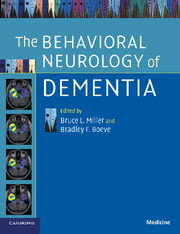Book contents
- Frontmatter
- Contents
- List of contributors
- Section 1 Introduction
- Section 2 Cognitive impairment, not demented
- Section 3 Slowly progressive dementias
- 18 Semantic dementia
- 19 Progressive non-fluent aphasia
- 20 Cognition in corticobasal degeneration and progressive supranuclear palsy
- 21 Cognitive and behavioral abnormalities of vascular dementia
- 22 CADASIL: a genetic model of arteriolar degeneration, white matter injury and dementia in later life
- Section 4 Rapidly progressive dementias
- Index
- References
20 - Cognition in corticobasal degeneration and progressive supranuclear palsy
Published online by Cambridge University Press: 31 July 2009
- Frontmatter
- Contents
- List of contributors
- Section 1 Introduction
- Section 2 Cognitive impairment, not demented
- Section 3 Slowly progressive dementias
- 18 Semantic dementia
- 19 Progressive non-fluent aphasia
- 20 Cognition in corticobasal degeneration and progressive supranuclear palsy
- 21 Cognitive and behavioral abnormalities of vascular dementia
- 22 CADASIL: a genetic model of arteriolar degeneration, white matter injury and dementia in later life
- Section 4 Rapidly progressive dementias
- Index
- References
Summary
Introduction
Progressive supranuclear palsy (PSP) and corticodentatonigral degeneration, later renamed as corticobasal degeneration (CBD), were originally described as unitary clinicopathologic entities and defined primarily as motor disorders with atypical parkinsonism lacking levodopa response, though the pathologic resemblance to Pick's disease was acknowledged for CBD. We now know that the relationship between these clinical entities and the pathology is not uniform, and nomenclature has changed as a result. The corticobasal degeneration syndrome (CBDS) is so named to distinguish it from the pathologic entity and has core features of asymmetric apraxia (cortical) and rigidity (basal ganglionic) with additional findings from each region such as cortical sensory loss, alien limb behavior, myoclonus or bradykinesia, dystonia, tremor. Pathology in CBD is characterized by lobar atrophy, which is mainly superior parietal and frontal with relative sparing of the occipital and temporal lobes (Munoz1998). Microscopically, the cortex contains swollen achromatic neurons, tau-positive glial plaques (the most characteristic feature of CBD) and rounded/fibrillary neuronal inclusions, also positive for tau. Another distinctive feature of CBD is the strong silver staining of the rounded inclusions with the Gallyas method, separating this pathology from the otherwise very similar findings in Pick's disease. Subcortical structures (mainly basal ganglia but also thalamus) demonstrate significant neuronal depletion, and rounded/fibrillary neuronal inclusions are seen here also. By comparison, PSP is typified by its symmetry, with limb and axial rigidity, a supranuclear gaze palsy and early falling.
- Type
- Chapter
- Information
- The Behavioral Neurology of Dementia , pp. 288 - 301Publisher: Cambridge University PressPrint publication year: 2009
References
- 2
- Cited by



